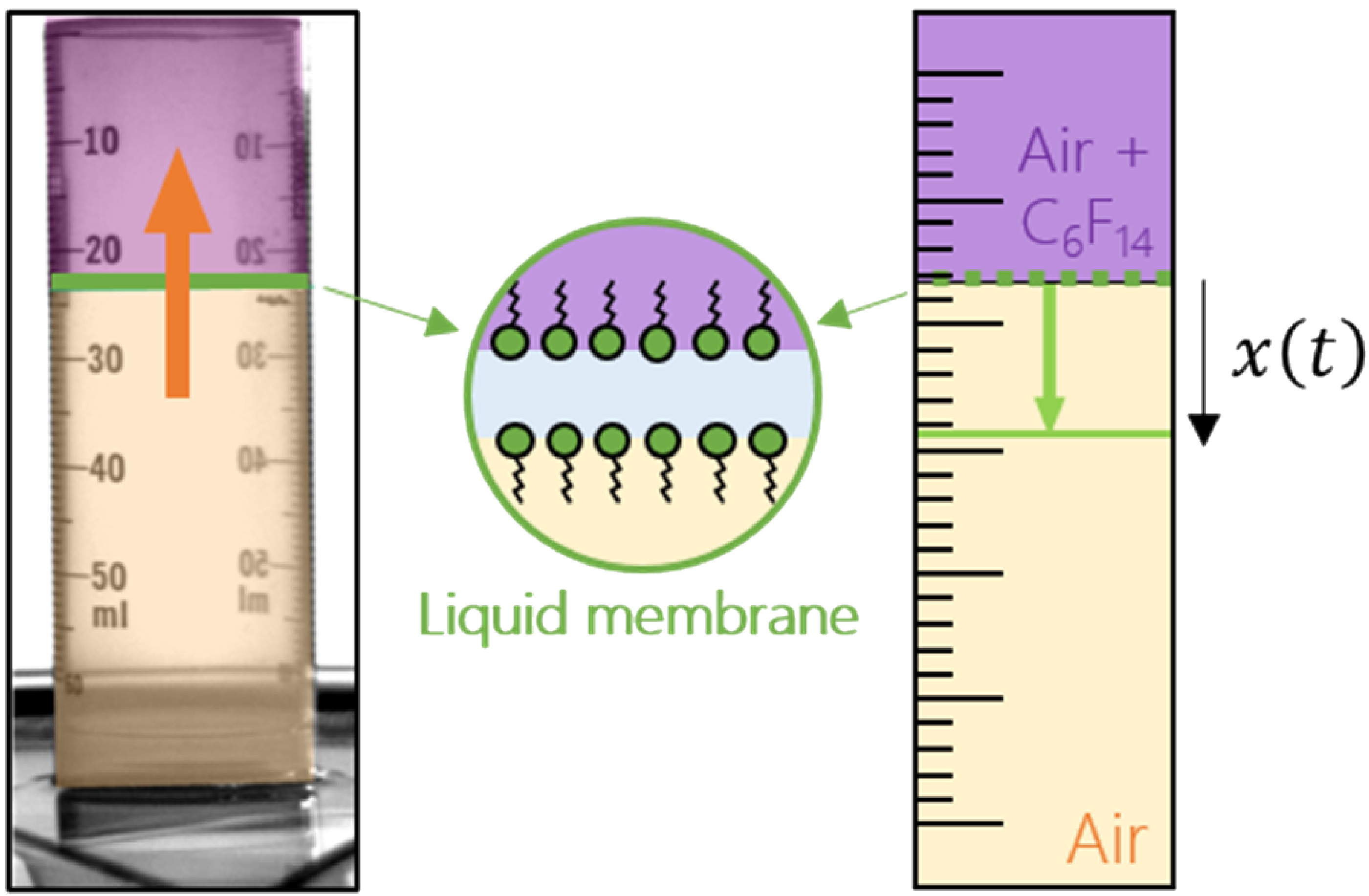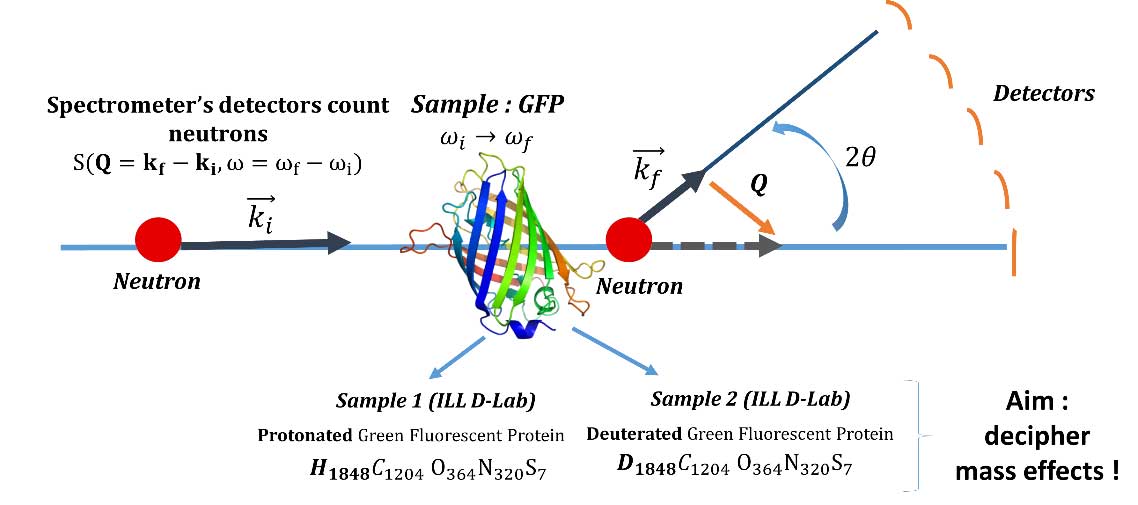- Share
- Share on Facebook
- Share on X
- Share on LinkedIn
Wetting and drying dynamics in superhydrophobic nanopores
Cyril PICARD, Marie PLAZANET and Élisabeth CHARLAIX, in collab. with Benoit COASNE (PSM team), Xavier CATTOËN (Institut Néel, Grenoble), Frédéric PIGNON (Laboratoire Rhéologie et Procédés, Grenoble) and Oskar PARIS (Montanuniversitat, Leoben, Austria)
We explore the equilibrium and transport of pure fluids and solutions within crystalline superhydrophobic materials consisting of nanometric or sub-nanometric pores. One of the experimental approaches relies on the study of transient wetting and drying regimes in these pores. This allows us to reveal, in the vicinity of the molecular scale, the thermodynamic role of contact lines via line tension, the heterogeneous nucleation processes of nanobubbles, the contact line anchoring phenomena on defects of a few angstroms, or the deformation of nanopores. These phenomena are at work in a wide range of natural and industrial systems. In the framework of this work, original approaches for energy storage and the valorization of new renewable sources are emerging.
Fundings: ANR LyStEn, ANR TamTam, Labex TEC21, Programme de prématuration CNRS
Dynamics of heterogeneous wetting in periodic hybrid nanopores
Cyril Picard, Valentin Gérard, Loïc Michel, X. Cattoen, Elisabeth Charlaix
Journal of Chemical Physics, 2021, 154 (16), pp.164710. ⟨10.1063/5.0044391⟩
Carbon dioxide as a line active agent: its impact on line tension and nucleation rate
Romain Bey, Benoit Coasne, Cyril Picard
Proceedings of the National Academy of Sciences of the United States of America, 2021, 118 (33), ⟨10.1073/pnas.2102449118⟩
The bowtie-shaped deformation isotherm of superhydrophobic cylindrical mesopores
Loïc Michel, Lukas Ludescher, Viviana Cristiglio, Elisabeth Charlaix, Oskar Paris, Cyril Picard
Langmuir, 2022, 38 (1), pp.211-220. ⟨10.1021/acs.langmuir.1c02427⟩

Nanofluidics for the valorization of renewable osmotic energy
Cyril PICARD, Élise LORENCEAU and Élisabeth CHARLAIX, in collab. with Jean-François MOTTE (Institut Néel, Grenoble), Vincent LARREY (Laboratoire d'Electronique et de Technologie de l'Information, CEA, Grenoble) and Anne-Laure BIANCE (Institut Lumière Matière, Lyon)
In nanofluidics, transport is largely controlled by fluid-solid interactions and the resulting interfacial phenomena. We study the coupling between hydrodynamics in the vicinity of the interface, electrokinetics and diffusio-osmosis with a view to applications in energy recovery and drinking water production. Beyond the intrinsic couplings at the nanoscale, these applications require to take into account all the phenomena that interact from the nanoscale to the macroscale. We are therefore conducting research based on single nanopores but also on the elaboration of hierarchical systems in order to optimize the nano/micro/macro couplings.
Funding: Région Auvergne-Rhône-Alpes
A Direct Sensor to Measure Minute Liquid Flow Rates
Preeti Sharma, Jean-François Motte, Frank Fournel, Benjamin Cross, Elisabeth Charlaix, Cyril Picard
Nano Letters, 2018, 18 (9), pp.5726-5730. ⟨10.1021/acs.nanolett.8b02332⟩

Filtration and gas capture with aqueous foams
Élise LORENCEAU, in collab. with Benoit COASNE (PSM team), Benjamin DOLLET (MOVE team), Hugues BODIGUEL (Laboratoire Rhéologie et Procédés, Grenoble), Marie LE MERRER, Anne-Laure BIANCE and Oriane BONHOMME (Institut Lumière Matière, Lyon)
Thin liquid films can be a game changer in the search for efficient gas separation and capture strategies. These fluid membranes, which are complementary to their solid counterparts involving porous materials, can achieve complex separation by combining permeability/adsorption mechanisms in the core of the liquid and at its surface, especially if they are loaded with surfactant molecules. In addition, the regeneration required between separation steps - a known hurdle for porous solid membranes - can be easily achieved using a continuous flow of liquid through the fluid film. In this context, aqueous foams, consisting of several hydrodynamically connected soap films, are of particular interest. We propose a multiscale approach to better understand the kinetics and flow rate of gas separation by aqueous foams.
At the molecular scale, we study the kinetics of gas transfer via a surfactant-loaded film using molecular dynamics simulations (collaboration with Benoit Coasne).
At the single film scale, we propose a simple experimental device allowing a direct quantitative evaluation of the permeability of soap films stabilized with different types of surfactants. In particular, this device allows the simultaneous measurement of the permeability ratio of a mixture of two gases. While for simple gas mixtures such as N2/O2 we find the expected theoretical values for the permeability ratio, we observe surprising modifications when we use N2/C6F14 or N2/CO2 mixtures. These effects are probably induced by an adsorption of C6F14 or CO2 on the hydrophobic tails of the surfactants.
At the scale of several films, we quantify the capacity of an aqueous foam to separate or store one of the gases in the liquid phase.
Fundings: Labex TEC21, IDEX Université Grenoble Alpes, Région Auvergne-Rhône-Alpes - Pack Ambition Recherche
Impact of Fluorocarbon Gaseous Environments on the Permeability of Foam Films to Air
Céline Hadji, Benjamin Dollet, Hugues Bodiguel, Wiebke Drenckhan, Benoit Coasne, E. Lorenceau
Langmuir, 2020, ⟨10.1021/acs.langmuir.0c02158⟩

Multiscale transport and acoustics in nanoporous media
Marie PLAZANET, in collab. with Benoit COASNE (PSM team)
Many technologies for separation, catalysis, storage etc. are based on adsorption and transport of fluids in nanoporous membranes. These membranes often need to be characterized under extreme temperature conditions or in aggressive environments. This project proposes to develop acoustic techniques to meet this need.
In this context, we propose to elucidate the acoustic signature of adsorption/transport in nanoporous materials from the atomic to the macroscopic scale. At each scale, experimental and theoretical techniques will probe the spontaneous acoustic emission generated by the fluid/solid system and its response to acoustic stimulation. Theoretical predictions will be compared to experimental data to obtain a “bottom-up” description of the acoustic signature. Ultimately, we will test the use of acoustic stimuli to modulate fluid adsorption/transport in nanoporous solids.
Funding: ANR ACOUFEN

Ionic transport through a liquid-liquid interface
Marie PLAZANET and Élise LORENCEAU, in collab. with Isabelle BILLARD (Laboratoire d'Electrochimie et de Physicochimie des Matériaux et des Interfaces, Grenoble) and Jean-François DUFRECHE (Institut de Chimie Séparative de Marcoule, Bagnols-sur-Cèze)
Recycling without polluting is one of the current challenges in chemistry requiring innovative liquid-liquid extraction systems. The processes can present static (baths) or flowing situations. Aqueous ternary mixtures with a critical point present behaviors or structurations that make their solubility or phase separation properties particularly interesting, while being less polluting solvents due to the large amount of water.
Following the proof of concept by Isabelle Billard and her team of the usefulness of aqueous biphasic systems composed of ionic liquids in acidic solution for the extraction of metals, we have been interested in the physical origin of the separation mechanisms. Now we propose to address fundamental questions about ionic transport across the interface between two immiscible but nonetheless aqueous solutions. The origins of the chemical potential difference experienced by the ions between the two phases and naturally allowing the transport from one phase to the other, strongly depending on the acidity and ionic strength of the solution, must be clarified. Moreover, fine relationships between different effects are expected: viscosity, surface tension, slip, advection or concentration polarization, coupled with instabilities of the liquid-liquid interface.
We are developing a co-flux microfluidic set-up allowing the characterization of the system along the channel by optical (composition) and X-ray (structural organization) spectroscopy. In parallel, molecular dynamics simulation and mesoscopic modeling will allow us to predict the different thermodynamic contributions and microscopic interactions driving the ionic transport across the interface.
Funding: IDEX Université Grenoble Alpes - IRS
How Temperature Rise Can Induce Phase Separation in Aqueous Biphasic Solutions
Gautier Meyer, Ralf Schweins, Tristan Youngs, Jean-François Dufrêche, Isabelle Billard, Marie Plazanet
Journal of Physical Chemistry Letters, 2022, 13 (12), pp.2731-2736. ⟨10.1021/acs.jpclett.2c00146⟩

Dynamics of Apolipoprotein B‑100 in Interaction with Detergent Probed by Incoherent Neutron Scattering
Judith PETERS, in collab. with Markus APPEL and Jacques OLLIVIER (Institut Laue-Langevin, Grenoble), Anna-Laurence SCHACHNER-NEDHERER, Gerd LEITINGER, Ruth PRASSL and Karin KORNMUELLER (Gottfried Schatz Research Center, Graz, Austria)
Apolipoprotein B-100 (apo B-100) is the protein moiety of both low- and very low-density lipoproteins, whose role is crucial to cholesterol and triglyceride transport. Aiming at the molecular dynamics’ details of apo B-100, scarcely studied, we performed elastic and quasi-elastic incoherent neutron scattering (EINS, QENS) experiments combining different instruments and time scales. Similar to classical membrane proteins, the solubilization results in remaining detergent, here Nonidet P-40 (NP40). Therefore, we propose a framework for QENS studies of protein−detergent complexes, with the introduction of a combined model, including the experimental apo B-100/NP40 ratio. Relying on the simultaneous analysis of all QENS amplitudes, this approach is sensitive enough to separate both contributions. Its application identified two points: (i) apo B-100 slow dynamics and (ii) the acceleration of NP40 dynamics in the presence of apo B-100. Direct translation of the exposed methodology now makes the investigation of more membrane proteins by neutron spectroscopy achievable.
Fundings: Fondation CFM pour la recherche, Campus France - PHC Amadeus, OeAD - WTZ
Dynamics of Apolipoprotein B-100 in Interaction with Detergent Probed by Incoherent Neutron Scattering
Aline Cisse, Anna-Laurence Schachner-Nedherer, Markus Appel, Christian Beck, Jacques Ollivier, Gerd Leitinger, Ruth Prassl, Karin Kornmueller, Judith Peters
Journal of Physical Chemistry Letters, 2021, 12 (51), pp.12402-12410. ⟨10.1021/acs.jpclett.1c03141⟩

The Matryoshka model for movements in lipid membranes
Judith PETERS, in collab. with Dominique BICOUT (Institut Laue-Langevin, Grenoble) and Tatsuhito MATSUO (Institute for Quantum Life Science, Tokai, Japan)
Lipid membranes are the basis of cell organization. Depending on their composition and their association with other molecules, they act both as a boundary for the cell and also as a filter that enters or leaves the cell. Understanding their functionality in light of their structure and dynamics is therefore crucial.
To this end, quasi-elastic neutron scattering (QENS) is a powerful tool to access the dynamics of lipid membranes on the picosecond time scale. However, for years, only a few models have examined local lipid dynamics, while the increase in neutron flux and data quality in new spectrometers requires new general models.
Inspired by the work of Pfeiffer et al. in the 1980s [Pfeiffer et al., Europhys. Lett. 8, 201 (1989)], the Matryoshka model is a generic model describing in the same framework the main local motions of lipid molecules and the organization of the dynamics on the separation of the molecules as proposed by Wanderlingh et al. [Wanderlingh et al., J. Chem. Phys. 140, 174901 (2014)].
Funding: Fondation CFM pour la recherche
The dynamical Matryoshka model: 2. Modeling of local lipid dynamics at the sub-nanosecond timescale in phospholipid membranes
Aline Cisse, Tatsuhito Matsuo, Marie Plazanet, Francesca Natali, Michael Marek Koza, Jacques Ollivier, Dominique J Bicout, Judith Peters
Biochimica et Biophysica Acta:Biomembranes, 2022, 1864 (9), pp.183950. ⟨10.1016/j.bbamem.2022.183950⟩

Nuclear quantum effects in biophysics
Judith PETERS, in collab. with Gerald KNELLER (Centre de Biophysique Moléculaire, Orléans & Synchrotron SOLEIL, Gif-sur-Yvette)
For several decades, incoherent neutron scattering data on biological samples have been analyzed by a classical approximate approach for lack of a complete quantum description of such highly complex systems. Knowing that proteins typically contain thousands or tens of thousands of atoms, it is indeed impossible to describe such systems by an exact Hamiltonian. Recently, our collaborator Gerald Kneller proposed a new method of spectroscopic interpretation based on Franck-Condon type probabilities of transitions between quantum states of the target. The obtained expressions for the scattering functions allow an analysis in terms of a quantum energy landscape of the neutron spectra as well as a physical interpretation of the correlation functions in the van Hove space-time using quantum effects.
Funding: CNRS MITI 2021 - Modélisation du vivant
Franck–Condon picture of incoherent neutron scattering
Gerald Kneller
Proceedings of the National Academy of Sciences of the United States of America, 2018, 115 (38), pp.9450-9455. ⟨10.1073/pnas.1718720115⟩

- Share
- Share on Facebook
- Share on X
- Share on LinkedIn